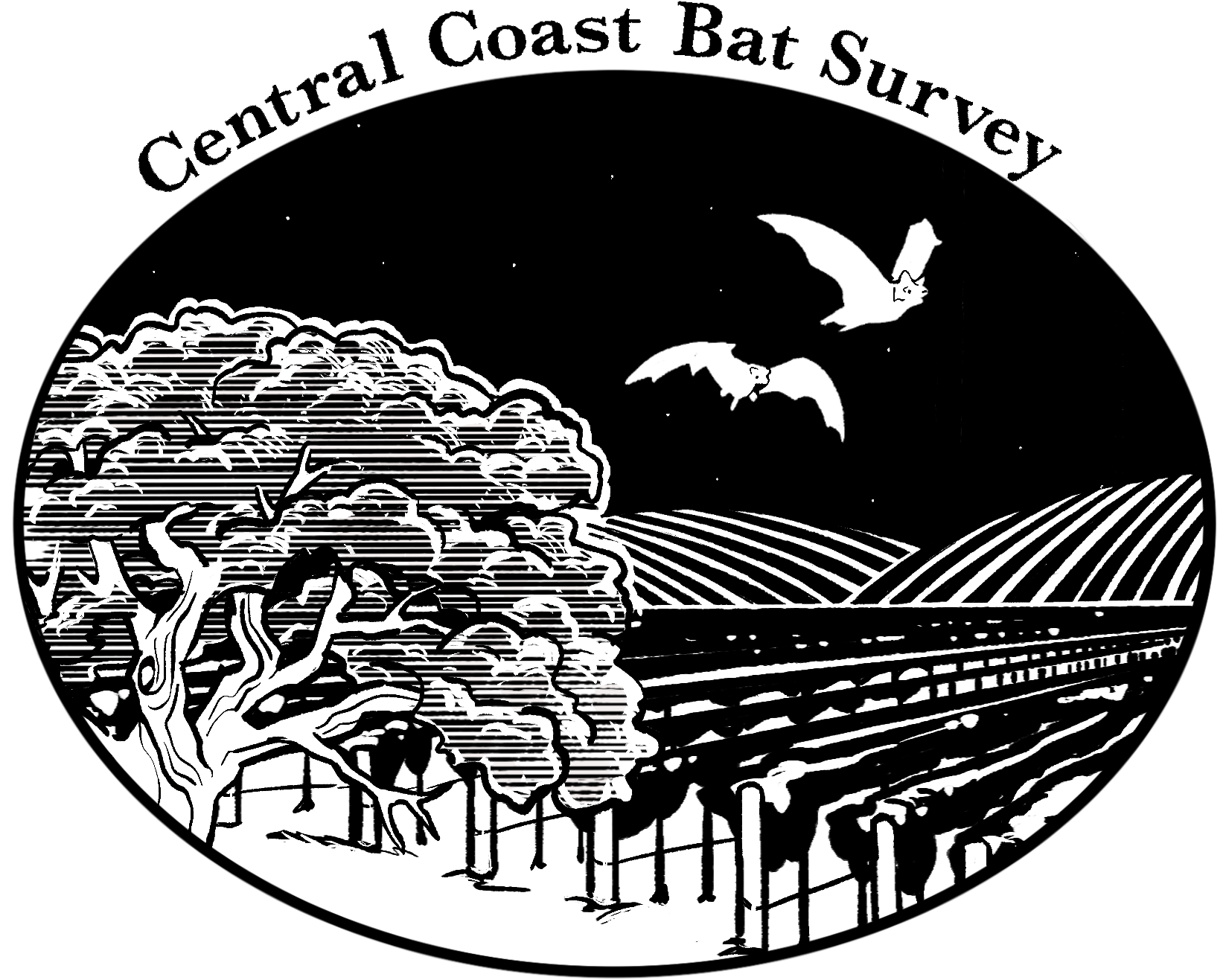A Key to the Bats of Central California
A DICHOTOMOUS KEY to the BATS OF CENTRAL CALIFORNIA and
CALIFORNIA'S CENTRAL COAST
1a. Interfemoral membrane lightly furred; fur uniformly black but many of the hairs distinctly silver-tipped, especially on dorsum; and face NOT distinctly lighter than back, then:
Lasionycteris noctivagans – Silver haired Bat
1b. If fur not as above; fur variously colored, go to #2.
2a. Tail extending (usu.>30mm) beyond edge of interfemoral membrane, go to #3.
2b. If no extension of tail beyond edge of interfemoral membrane, go to #4.
3a. If forearm more than 70mm, ears reach beyond the nose when laid forward; no bristle-like hairs on rump, then:
Eumops perotis – Western Mastiff Bat
3b. If ears joined at base and forearm more than 52mm, then:
Nyctinomops macrotis – Big Free-tailed Bat
3c. If ears joined at base and forearm less than 52mm, then:
Nyctinomops femorosaccus – Pocketed Free-tailed Bat
3d. If ears not united at base and forearm less than 55mm, then:
Tadarida brasiliensis – Mexican Free-tailed Bat
4a. If ears proportionally large relative to body, more than 25mm from notch to tip, color black with three large white spots on back, one just behind each shoulder and the other at the base of the tail, then:
Euderma maculatum - Spotted Bat
4b. If ears more than 20mm in height from notch to crown but pelage not black; no white spots on back, then go to #5.
4c. If ears less than 20mm in height from notch to crown, then go to #6.
5a. If ears widely separated; hair yellow next to skin and dorsum pale yellow or straw in color; forearm (radius) more than 46mm; and large-eyed, then:
Antrozous pallidus – Pallid Bat
5b. If ears close together at anterior base, hair dark gray next to skin, ventral hairs with pale pink tips and forearm less than 46 mm, then:
Corynorhinus townsendii pallescens – Townsend’s Big-Eared Bat
6a. Dorsal surface of interfemoral membrane bare, or if slightly furred, at most lightly furred on the anterior third, hairs of back not tipped with white, go to #8.
6b. Dorsal surface of interfemoral membrane densely furred, go to #7
7a. Color red/red-orange, silver tips on dorsal hairs, forearm more than 45 mm, then:
Lasiurus cinereus – Hoary Bat
7b. Color brick red, flame red, or orange red, occasionally silver tipped, especially in neck collar; forearm less than 45mm; then:
Lasiurus frantzii – Western (aka Peters') Red Bat
7c. Color yellow/yellow-gray, forearm 40-45 mm and body length less than 120mm, then:
Dasypterus xanthinus – Western Yellow Bat
8a. First visible tooth behind upper canine about 1/2 as high as the canine and in contact with it at base, go to #9.
8b. First visible tooth behind the upper canine less than 1/3 as high as canine, or if 1/2 as high, then separated from the canine by a noticeable gap, go to #10.
9a. Forearm more than 40 mm; tragus short, broad with a rounded tip; calcar keeled; then:
Eptesicus fuscus – Big Brown Bat
9b. Forearm less than 40 mm; small body (6.5-7.5cm); tragus short (<5 mm), blunt, and slightly curved, then:
Parastrellus hesperus – Canyon Bat
10a. Dorsal surface of interfemoral membrane only furred on anterior half; short tail extending beyond often with one (at most two) vertebra evident; foot <8 mm; dorsal fur glossy; wings and tail membrane black, then:
Myotis ciliolabrum – Western Small-footed Myotis
10b. Dorsal anterior surface of interfemoral membrane without dense fur, foot > 8.5 mm, go to #11
11a. Ear when laid forward extending >2 mm beyond tip of nose, ear more than 16mm from notch to tip, go to #12
11b. Ear when laid forward extending <2 mm beyond tip of nose, ear less than 16mm, go to #13
12a. With a fringe of stiff hairs on posterior edge of the interfemoral membrane, then:
Myotis thysanodes – Fringed Myotis
12b. Without a conspicuous fringe of hairs on edge of interfemoral membrane; ears pitch black, opaque; 20-25mm, then:
Myotis evotis – Long-eared Myotis
13a. Calcar with distinctive keel, go to #15.
13b. Calcar without keel, go to #14.
14a. Skull < 14 mm, total length, fur w/dull luster; body two-toned (darker on back, lighter on underside); then:
Myotis yumanensis – Yuma Myotis
14b. Skull > 14 mm; fur usually glossy, then
Myotis lucifugus – Little Brown Myotis
15a. Forearm 37 mm or more, then
Myotis volans – Long-legged Myotis
15b. Forearm 35 mm or less, then
Myotis californicus – California Myotis
